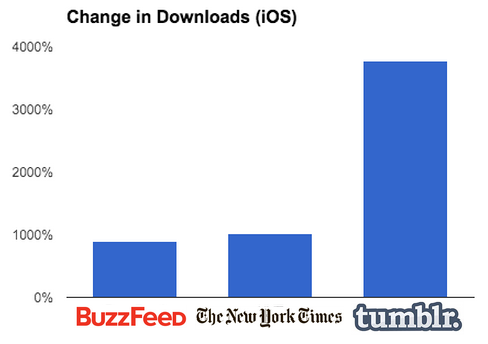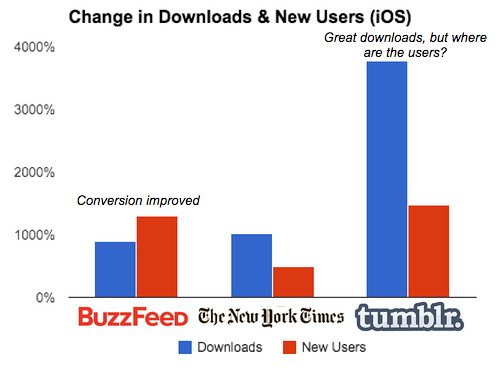|
Every start-up dreams about being mentioned in The New York Times. A dash of NY Times ink provides credibility to your idea and drives usage, or so the logic goes. But in today's rapidly changing media landscape, does this still hold true? Based on my experience with TalkTo, the answer is a resounding NO. In fact, even large websites like BuzzFeed may not provide a huge boost to your business. The holy grail of driving traffic: raving fans writing genuine reviews for a small but passionate readership. I came to this conclusion by comparing how press coverage from three outlets improved our average daily iOS downloads. I looked at daily downloads 5 days prior to each article and 5 days after each article. TalkTo, which was acquired by Path in June, has been covered by many of the major publications but for this study I looked at mentions in The New York Times (Old Media), BuzzFeed (New Media), and Tumblr (Social Media). A Tumblr blog posted by an angsty 20-something from Canada named HeyitsJnnfr increased downloads by a factor of 38; in other words, if we got 1 download prior to the blog, we got 38 the following week. Jennifer nailed a particular use-case: "people who suffer from social anxiety where telephone communications might be triggering or uncomfortable." This message resonated with her 2,500 followers who started to like and reblog the post. As of today, this obscure blog has been shared by 89,000 people. In comparison, BuzzFeed, with 1.41 million Twitter followers and 3.8 million Facebook likes, drove a 10X increase in downloads. The New York Times (13 million Twitter, 8.5 million Facebook) drove slightly more downloads than BuzzFeed and but far fewer than Heyitsjnnfr's post. Downloads are only half of the battle. The other key element is conversion, i.e. the number of people that download, open and use the app. In this metric, BuzzFeed was the best. As you can see from the chart below, the 5-day before/after change in BuzzFeed New Users outpaced downloads. Tumblr, on the other hand, was pretty abysmal: A 38X increase in new users only yielded a 16X increase in New Users. The New York Times was similar to Tumblr. Key Take Aways
6 Comments
Over the past six months, Spottah managed to quiet the "Lizard Brain." It was an amazing streak that would make Seth Godin proud. We delivered a minimal viable product, a beta and two Apple App store releases without thrashing. But like all great streaks, ours came to an end. Between Sunday night and Wednesday morning, we violently thrashed. Think boated Great White.
Without getting into great detail, we planned to push an App Store update on Sunday night. Since releasing our first version in mid-May, we identified a few bugs and “stumble points.” My favorite: Facebook Connect in Norwegian dialect. So we drafted a 20-item requirements list in Pivotal Tracker. One-by-one Spottah’s amazing development team delivered. On Saturday night we received a TestFlight. Every requirement worked. One final call on Sunday to “push the button together.” Sunday. 4PM. The team assembled. We agreed: the new build is tight. We thanked the development team. They, like always, said don’t worry about it. Then it happened. Our partner in charge of the front-end threw out a final request. Our back-end developer said it shouldn’t be too hard, and that he’ll look into it. “Great,” I said. “Look into it. If it isn’t too difficult, go for it.” And so began the thrash. One fix caused four problems. And in the end, the request had the opposite effect: it slowed Spottah down. How did this happen? Why am I so upset that we thrashed? And most importantly, how will the team ensure that this does not happen again? How did this happen? Over-confidence and a lack of discipline caused Spottah’s thrash. During the six months the team has been together, there has not been a single programming challenge that our developers could not solve – quickly. With each precise and timely delivery, confidence grew. Discipline, in turn, waned. After all, why be disciplined in your decision-making when every task is doable? So on Sunday, when the extraneous request was proposed, I had no doubt that the team could deliver. Instead of being a disciplined project manager and asking a line of questions (Do customers want/need this? How will implementing this one item affect other parts of the application?), I resorted to the worst logic in product development: If doable, than do it. Why I’m so upset? I’m upset because thrashing strains the team. The development team bears the brunt of the strain. Developing a beautiful application that is easy-to-use and reliable is difficult, to say the least. Thrashing makes the process more difficult and lowers morale. Who likes investing hours into building something, only to find out after a few seconds of usage that it makes the product worse? And it doesn’t end there. Additional hours are required to undo the now-useless requirement. It’s like building a house, realizing you don’t want to live on that particular street, and then dismantling the house. The business side is strained, too. Since the Apple update process requires deliberate action by the consumer, you don’t want to push the product too hard knowing that an update is in the not-too-distant-future. It makes little sense onboarding people on Tuesday only to ask them on Wednesday to update. Since the business-side is measured by active users (at Spottah, at least) it is stressful to delay marketing efforts. Overall, thrashing harms the team dynamic. While one side of the team burns the mid-night oil, the other is left sitting on their hands. Steps for avoiding future thrashes 1. Invest the time up-front to develop a sensible requirement list….and stick to it! Spottah did the first step. We had a requirement list that addressed bugs, UX improvements and performance. We nailed all 20 items on the list. The one item not on our list led to a thrash. 2. Exceptions to Step 1 can be made but be doubly – no triply – sure you need it. It is naïve to say that you shouldn’t adjust a plan made three weeks earlier. Things change. You could have completely missed something in your customer research. Or, a technology in the stack can change, thus forcing your hand. But before rushing to add an additional requirement: i. ensure that it is absolutely necessary; and ii. understand how it will affect the feel and performance of the product as a whole. 3. Don’t get lazy. We were tired and distracted that fateful Sunday. We had been pushing hard while balancing life; for example, I took the call between my sister’s graduation party and a trip to the movies with my nieces. Under such circumstances, it’s easier to say “Go for it” than it is to ask the hard questions. But in reality, it is easier to be disciplined up-front than it is to unwind a mess caused by small-thinking. DiMaggio’s streak ended in th 57th game. The Patriot’s Perfect Season slipped away in the Super Bowl. And Spottah’s thrash ended a solid run of ships. But we’re a young team and the new season starts today. As 2011 comes to a close, I want to celebrate the blogs that caught my attention, made me think, and taught me a lesson or two. So without further adieu, I present my favorite 5 blogs of 2011. The Sincerest Form of Flattery, by Matt Brezina, CEO of Sincerely When Apple launched Cards, an app for sending physical cards, my heart sank. My close friend of more than 10 years had just launched Sincerely and its flagship product Postagram. Apple entered the exact market my friend Matt was creating. Before turning in for the night, I checked Twitter one more time and saw that Matt posted this blog. I read it. By the end of the post, I realized Sincerely wasn’t scared of the competition; on the contrary, it was energized by it. So, if you’re running a company and a bigger competitor enters your space, use the opportunity to change the conversation. This post does three things particularly well.
4. Secrets aren’t necessary What Powers Instagram: Hundreds of Instances, Dozens of Technologies by Instagram Companies are secretive. Coca-cola locks its recipe in a safe. Apple goes to extraordinary lengths to veil new products. It refreshing, therefore, when a company comes out and says, “Hey, this is how we do things.” And no company did this better than Instagram, the photo sharing mobile app that launched this year and already has more than 12 million users. In this blog post, Instragram shares its IT strategy. Anyone interested in launching a competitive product could – and should – follow each and every recommendation. And that is the point: when you have a branded product that consumers trust – in Warren Buffett’s terms a “moat” – it does not matter if your competitors or customers know how the product gets delivered. Having the exact recipe or a head-start on a new product does not make it any more likely that Coke or Apple will be disrupted. The same goes for Instagram. Understanding how Instagram delivers beautiful photos to your mobile devices does not mean a competitor can replace them through replication. A new competitor needs to identify what Instagram is missing and then fill that customer need. 3. IPOs and private markets IT'S OFFICIAL: The IPO Market Is Crippled -- And It's Hurting Our Country by Alan Patricof A major story throughout 2011 was Facebook’s valuation on the private markets. As of September, the company was valued at $82 billion on SharePost. But there was a bigger story than just the billions Facebook was worth. If a global brand with profits and exponential growth had not already gone public, what did that say about the IPO market overall? In a blog on Business Insider, Greycroft’s Alan Patricof poured onto the page the knowledge he has gained from over 30 years of early stage investing. He concluded that companies, particularly smaller ones, no longer have the opportunity to go public and as a result America is losing its technological advantage. The decline in the IPO market is the result of four factors:
2. Added to my lexicon in 2011: “Napkin Entrepreneur” Napkin Entrepreneurs by Steve Blank I judge a blog based on how often I reference it in my daily life. This year, I added a new phrase to my lexicon: Napkin Entrepreneur. Steve Blank, a start-up veteran and thought leader, wrote a perfect summary of today’s start-up environment. Basically, the amount of capital required to start a business has fallen dramatically while the number customers you can reach has risen dramatically. As a result, dreamers no longer need to sketch out a plan on a cocktail napkin. Rather, they can hack the product together and deliver it to millions of users at zero cost. If the feedback is positive, keep going. If it is negative, move onto the next idea. The Napkin has been replaced with the beta product. 1. Don't worry about Marauders Speech by Elizabeth Warren, Senate candidate in Massachusetts (Starts at 00:48) Last summer I took a class at NYU Stern that forever changed my perspective. The class was called Global Perspectives on Enterprise Systems and it was taught by Robert Wright. The goal of the class was to understand why some countries develop rapidly, like the United States, while others do not develop at all. It came down to the “Growth Diamond;” Stern professors notoriously love baseball. Home plate is a non-predatory, Lockean government. In other words, growth starts with a government that protects the life, liberty and property of its citizens. Such a government collects taxes transparently, regularly and at a reasonable rate. The government also establishes and enforces reasonable laws. Note that such a government does not need to be a democracy; though they often are. The next phase of development, or first base, is a financial system in which capital moves from savers to borrowers. First base cannot be reached without home plate; after all, the crux of saving and lending are contracts recognized by the courts established by the government. With home plate and first base established, the economy is prepared to take second base: entrepreneurship. Individual actors are comfortable investing into a long-term business knowing that the government will not pilfer it in the night. And even if something goes wrong, the actor has faith that the slip of paper called “insurance” will be made good. And lastly, the actor has access to capital, thanks to first base. Interestingly, not all economies move equally between bases. There are countries with non-predatory governments and financial systems that have less entrepreneurship than others. The final stage, third base, is a management system. Basically, the entrepreneurs that flourished from a stable government and access to capital eventually grow into large, distributed organizations. These organizations have the systems required to undertake large and complex markets like air travel, chip fabrication and automobile manufacturing. So what does this have to do with Elizabeth Warren? Simple. She understands the Growth Diamond, and more than anything she can articulate it to the American people. This speech lit-up the blogosphere and belongs in the annals of great speeches made by great Americans. |
JONATHAN STEIMAN
I'm the Founder and CEO of Peak Support. This blog is my take on early-stage companies and innovation. Every so often, there may be a post about culture, networking, family -- you name it. After all, what is a blog if it isn't a tad bit unstructured.
Archives
December 2016
Categories
All
|


